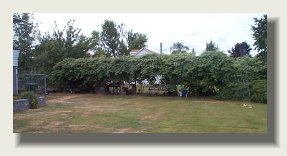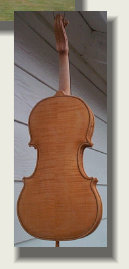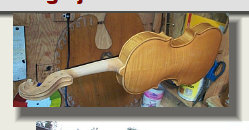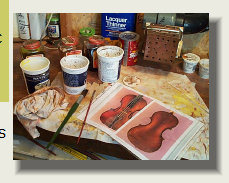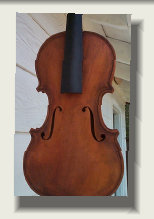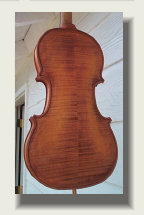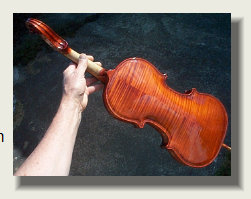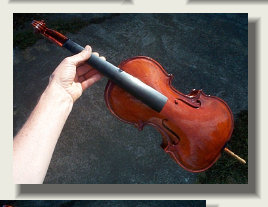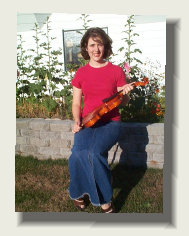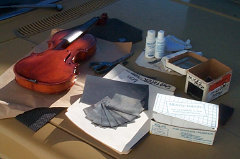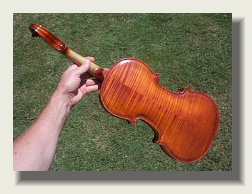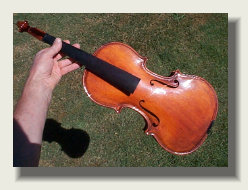

...Violins are finished outside with
protective coatings of varnish.
They are unfinished on their inside surfaces because any finish applied there has a negative effect on tone.
...My usual appoach (I am willing to work with customers for special needs) is to select the appearance I want for the particular instrument, often from the fine color plates in Strad Magazine.
...Using permanent water stains made especially for instrument making, I try to make the wood look like my photographic model for the violin. Working with five basic colors, in various combinations, very satisfying results can be produced.
...When I am satified with the appearance, and after hanging outside to dry, the violin is sealed with a special shellac or a ground coating. This provides a secure base for the varnish coats to follow as well as sealing the wood so the varnish does not penetrate into the wood pores (which could have a negative effect on the sound).
...The next step is to recapitulate this coloring process in Seven layers of hand applied instrument oil varnish colored with special liquid coloring extracts for varnish, imported from Europe (the varnish now costs about $ 1,200 per gallon).
...I try and apply the darkest shades first with each layer lighter than the previous and end with two clear varnish top coats.
...This process of coloring the instrument with the permanent water based stains and then re-stating the color in varnish seems to give greater depth and interest to the appearance of the completed instrument.
...The finish coats are applied over seven days. I believe this method is superior because each varnish coat chemically bonds with the previous layer which is not fully cured. (Some makers let each layer of varnish dry for an extended period of time; in this case the next layer of varnish only has a mechanical bond to the sandpaper roughened surface of the prior coat which would be far weaker than the chemically bonded method I am using).
...It is somewhat incorrect to speak of oil varnish 'drying', as a truly hard varnish layer on our instrument (as on inexpensive factory made violins) hurt the tone; rather a softer, continually flexible protective surface is what is desired. Proper oil varnish is fully cured in eight years.
...Once the varnishing is completed and has set up sufficiently, I hand sand the surface to made is level and very smooth. Usually I begin with #400 silicone carbide paper over a foam block, followed by #600, then the Micro-Mesh brand flexible silicone carbide papers in nine steps of #1500 #1800 #2400 #3200 #3600 #4000 #6000 #8000 #12000.
..At this point the surface has a considerable shine, however, if a more brilliant shine is desired, than a hand polish with lineseed oil and rottenstone abrasive on a felt pad bring the surface to a fine luster.
...The sanding- polishing process occupies most of a morning (four hours).
...I believe that this process will give a lasting violin finish that enhances the tone of the instrument, gives continual visual satisfaction, and should provide several hundred years of protection.
...
..In addition I usually add a Flitz polish which then improves varnish sound contribution without having to wait for 50 years!
Notice the nicely
tanned color from
a month in my ultra-
violet light treating box.
Customer inspecting progress: If you wish, you may stop in to visit my shop from time to time to watch progress of your violin over the three months from start to
completion.
Modified 7/2017
Page LBC_7



